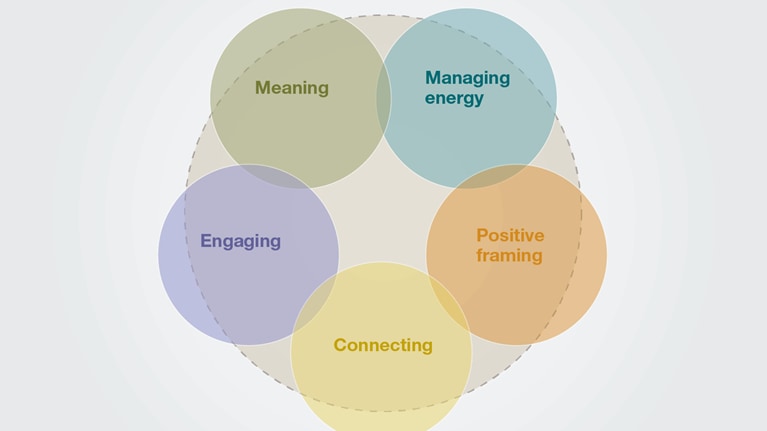The vast majority of companies, according to the results of a recent McKinsey survey,1 believe that economic growth in developing markets is important to the success of their business strategies. And more than two-thirds of those companies are engaged in various programs to encourage that growth, whether through education or private-sector development or technological advancement.
But many of these programs may be less effective than they could be, the survey results suggest. That’s because only 19 percent of respondents say their companies’ development programs focus on women, even though a great deal of recent research by the World Bank, the United Nations, and academic scholars indicates that programs focused on women generate better outcomes, in terms of specific program goals and overall development objectives. For instance, an extra year of secondary schooling has been demonstrated to increase women’s future wages by 10 to 20 percent, significantly higher than the 5 to 15 percent return observed among men.2 In addition, women who earn income are especially powerful catalysts of development because they reinvest a larger portion of their income in the health, education, and well-being of their families, compared to men.3
The survey asked senior executives from companies headquartered around the world if and how their companies operate in developing markets, whether they are addressing social issues tied to economic development, and whether any of their development programs focus on women. The survey also asked about whether and how focusing on women has affected profits at these companies and, for companies not focused on women, what might cause them to do so.
It is particularly notable that most respondents to this survey whose companies focus their development programs on women say the focus has boosted profits or will do so soon. This is surprising because, in general, companies have great difficulty making financial assessments of the corporate benefits of social investments. Respondents’ ability to see a clear link to profits likely results from a combination of the issues companies are addressing (particularly education), the targets of their programs (most often current and future employees), and the multiplier effect of focusing on women.
How companies are spurring development
Three-quarters of the companies represented in the survey are somehow active in developing markets,4 most often by making sales in those countries and having offices there. And the vast majority say economic growth in those markets is now and will continue to be important to the success of their business strategies. So, for most companies, there are clear business reasons to support growth in developing countries. Indeed, the importance companies place on encouraging such growth is highlighted by the finding that, even during the past calendar year of economic crisis, most of the companies addressing issues in developing markets have at least maintained their previous levels of engagement, while 38 percent have increased it.
Survey respondents identify education, trade and economic integration, and private-sector development as the top drivers of economic growth in developing markets over the next ten years (Exhibit 1). These drivers overlap with the top three issues that companies are seeking to address in some way: education, technological advancement, and private-sector development.5
Top drivers of economic growth
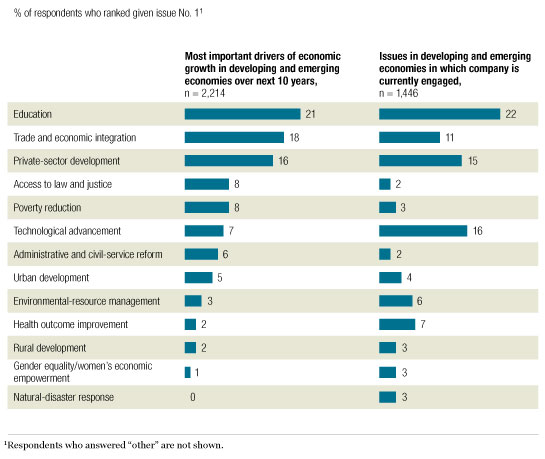
Focusing on women
Among executives at companies addressing one or more development issues, only 19 percent say their programs focus on women—that is, programs that specifically promote gender equality or women’s economic advancement or that make women the central focus of programs with other aims (Exhibit 2). Notably, in comparing responses from these companies with responses from companies that have not focused on women in their development programs, the same issues—education, trade and economic integration, and private-sector development—are seen as important and are most frequently addressed. What’s different is just the choice of a women-specific angle.
It must be noted that addressing these issues—even without a focus on women—often helps women’s economic position significantly. However, programs that focus specifically on women create more benefit for women and society as a whole, according to many studies over the past 15 years. Countries that have not achieved gender parity in education, for example, have been found to forgo 0.1 to 0.3 percentage points annually in per capita economic growth.6 Further, a one-year increase in schooling of all adult females in a country is correlated with an increase in GDP per capita of roughly $700 and a 0.7 percent increase in the participation of women in the formal labor force.7 Compounding these effects is the fact that educated and employed mothers have a stronger positive influence on the health and educational outcomes of their children than do similar fathers.
Where the focus is on women
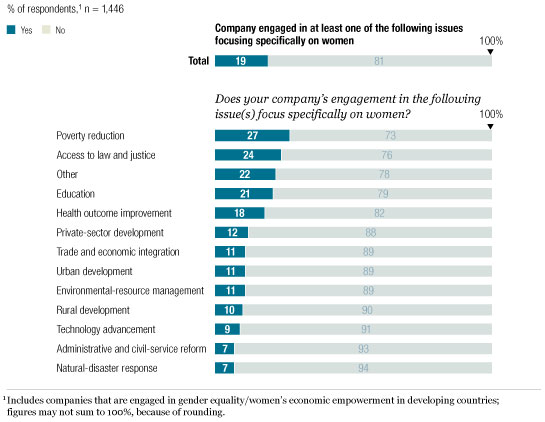
At the companies focused on women’s development, the most common reason for that decision is that the focus is consistent with company culture or tradition. These companies’ programs most often target current and future employees, closely followed by women in society at large. Consistent with a focus on employees, three-quarters of respondents describe their efforts as programs and policies to hire, retain, or advance female workers in developing economies (Exhibit 3).
How companies engage with women’s development
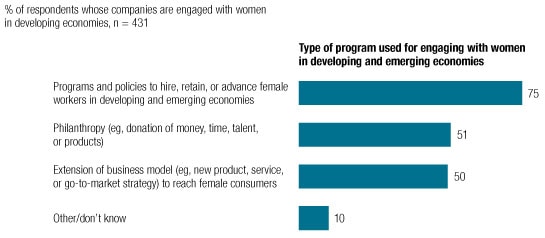
Missing a chance for higher profit?
Among respondents whose companies are engaged with women on development issues, 34 percent say the engagement has already increased profits, and another 38 percent expect it to do so, most often by increasing the pool of skilled and accessible labor (Exhibit 4). Given how hard it can be for companies to assess the financial benefits they can gain from social programs, this finding is initially startling. However, it is less so considering the research measuring benefits from programs that focus on women and the fact that many respondents’ programs focus on education and generally target current and potential employees. Notably, executives at companies with programs that don’t focus on women say the same labor force benefits already reported by others would encourage them to adopt such programs (Exhibit 5).
So why do relatively few focus on women? One reason is that many companies don’t know that such a focus can increase the social impact of many programs. Two-thirds of respondents to this survey say that their companies have been unaware of the research or that they don’t know whether the company is aware of it. Furthermore, respondents at more than half of these companies say they have never considered focusing on women as a distinct strategic or philanthropic priority.
Profits from women
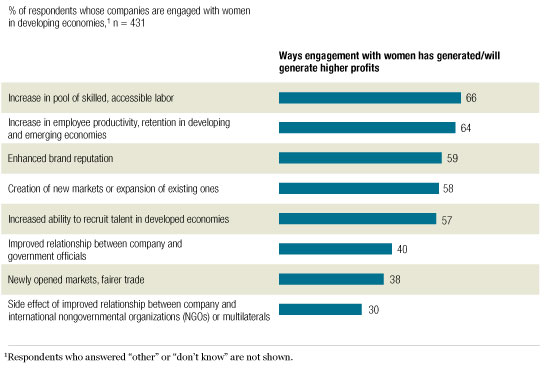
Compelling reasons
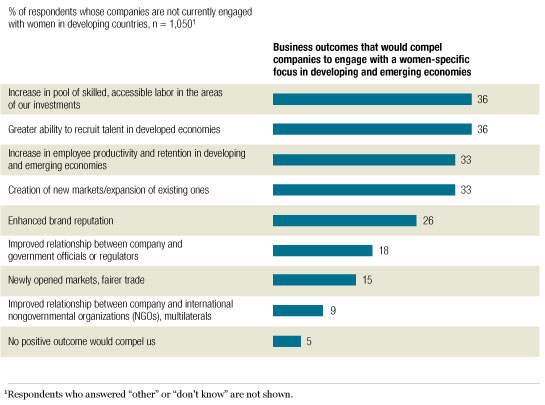
Beyond that, companies are typically aware that addressing social issues can create hard business benefits beyond maintaining or improving reputation—particularly in improving employee morale and retention.8 However, these effects can be hard to measure and often aren’t considered when assessing social programs. For example, in a McKinsey survey from January 2009,9 three-quarters of CFOs and investment professionals said social programs make positive long-term contributions to shareholder value, but only 37 percent said that’s true in the short term. For the most part, respondents to that survey said value comes from maintaining a good corporate reputation broadly, and most respondents were unable to fully integrate the effects of social, environmental, or governance programs into financial analyses. In common with those findings, 35 percent of respondents to this survey say they would most likely focus development programs on women if such a focus would generate additional value or improve corporate performance, while nearly half say they would do so in response to internal or external pressure of other kinds (Exhibit 6).
As long as these attitudes persist, both the potential to create short-term financial benefits from social investment and the multiplier effect of focusing on women are unlikely to occur to most companies.
Money motivates—sometimes
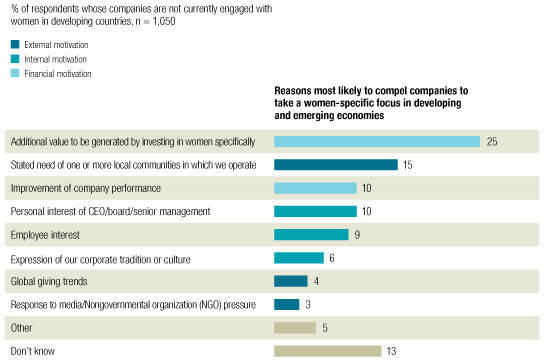
Looking ahead
If they do not already do so, companies can likely make many programs—such as those in education—more effective for communities and themselves simply by incorporating a focuson women.
Companies appear to see investing in education as a way to address many social issues; thefact that doing so also builds a larger, more qualified labor force is a clear additional benefit.
